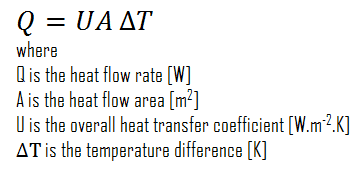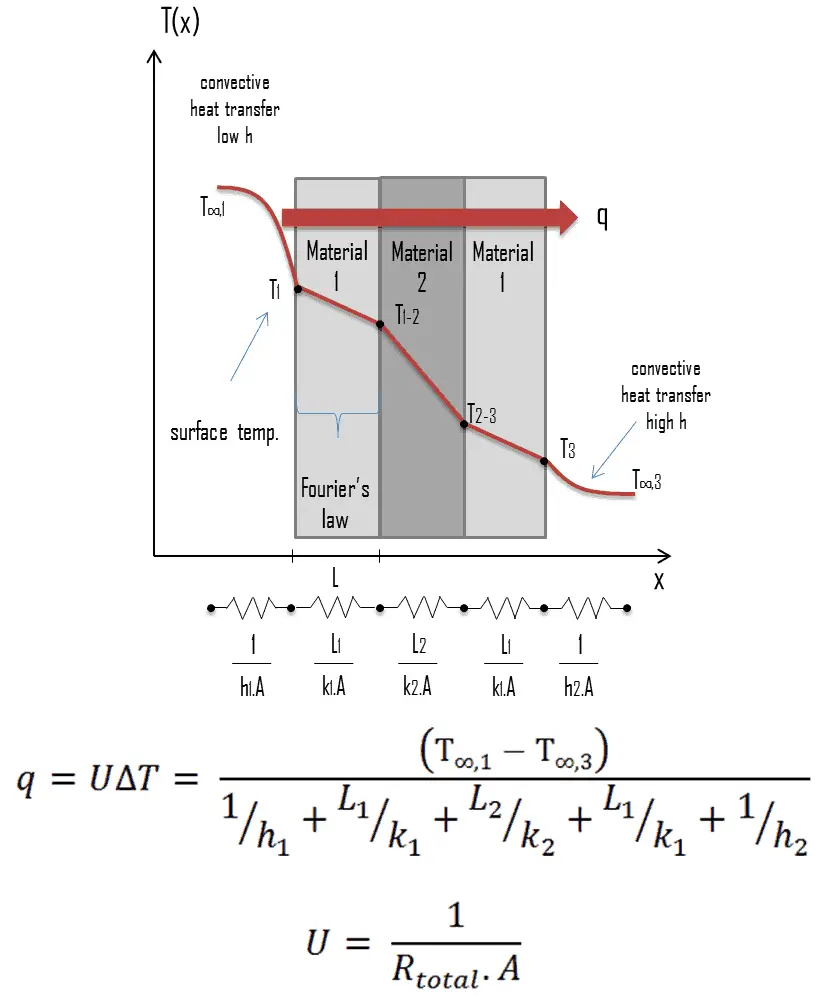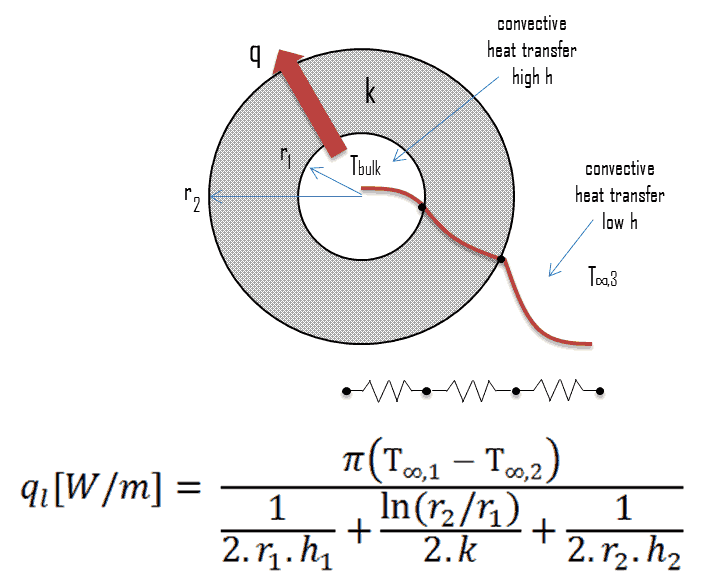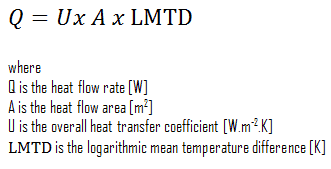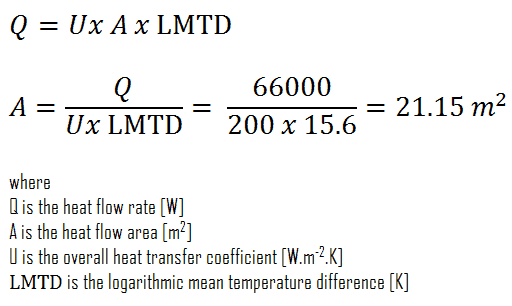Heat Exchanger Analysis – Heat Exchanger Calculation
Heat exchangers are commonly used in industry, and proper design of a heat exchanger depends on many variables. In the analysis of heat exchangers, it is often convenient to work with an overall heat transfer coefficient, known as a U-factor. The U-factor is defined by an expression analogous to Newton’s law of cooling. Moreover, engineers also use the logarithmic mean temperature difference (LMTD) to determine the temperature driving force for heat transfer in heat exchangers.
Special Reference: John R. Thome, Engineering Data Book III. Wolverine Tube Inc. 2004.
These terms and methods, which are widely used to select an appropriate heat exchanger, are described below.
Heat Exchanger Analysis – Performance Calculation
Overall Heat Transfer Coefficient
 A heat exchanger typically involves two flowing fluids separated by a solid wall. Many of the heat transfer processes encountered in industry involve composite systems and even involve a combination of both conduction and convection. Heat is first transferred from the hot fluid to the wall by convection, through the wall by conduction, and from the wall to the cold fluid again by convection.
A heat exchanger typically involves two flowing fluids separated by a solid wall. Many of the heat transfer processes encountered in industry involve composite systems and even involve a combination of both conduction and convection. Heat is first transferred from the hot fluid to the wall by convection, through the wall by conduction, and from the wall to the cold fluid again by convection.
With these composite systems, it is often convenient to work with an overall heat transfer coefficient, known as a U-factor. The U-factor is defined by an expression analogous to Newton’s law of cooling:
The overall heat transfer coefficient, U, is related to the total thermal resistance and depends on the geometry of the problem. For example, heat transfer in a steam generator involves convection from the bulk of the reactor coolant to the steam generator inner tube surface, conduction through the tube wall, and convection (boiling) from the outer tube surface to the secondary side fluid.
In cases of combined heat transfer for a heat exchanger, there are two values for h. There is the convective heat transfer coefficient (h) for the fluid film inside the tubes and a convective heat transfer coefficient for the fluid film outside the tubes. The thermal conductivity (k) and thickness (Δx) of the tube wall must also be accounted for.
Logarithmic Mean Temperature Difference – LMTD
In order to solve certain heat exchanger problems, engineers often use a log mean temperature difference (LMTD), which is used to determine the temperature driving force for heat transfer in heat exchangers. LMTD is introduced due to the fact, the temperature change that takes place across the heat exchanger from the entrance to the exit is not linear.
The heat transfer through the wall of heat exchanger at a given location is given by the following equation:
 Here the value of overall heat transfer coefficient can be assumed as a constant. On the other hand the temperature difference continuously varies with location (especially in counter-flow arrangement). In order to determine the total heat flow, either the heat flow should be summed up using elemental areas and the temperature difference at the location or more conveniently engineers can average the value of temperature difference. The heat exchanger equation can be solved much easier if we could define a “Mean Temperature Difference” (MTD). It can be seen from the figure that the temperature difference varies along the flow and the arithmetic average may not be the real average, therefore engineers use the logarithmic mean temperature difference. The “Logarithmic Mean Temperature Difference“ (LMTD) is a logarithmic average of the temperature difference between the hot and cold feeds at each end of the heat exchanger. The larger the LMTD, the more heat is transferred. It can be seen from the figure that the temperature difference varies along the flow and the arithmetic average may not be the real average.
Here the value of overall heat transfer coefficient can be assumed as a constant. On the other hand the temperature difference continuously varies with location (especially in counter-flow arrangement). In order to determine the total heat flow, either the heat flow should be summed up using elemental areas and the temperature difference at the location or more conveniently engineers can average the value of temperature difference. The heat exchanger equation can be solved much easier if we could define a “Mean Temperature Difference” (MTD). It can be seen from the figure that the temperature difference varies along the flow and the arithmetic average may not be the real average, therefore engineers use the logarithmic mean temperature difference. The “Logarithmic Mean Temperature Difference“ (LMTD) is a logarithmic average of the temperature difference between the hot and cold feeds at each end of the heat exchanger. The larger the LMTD, the more heat is transferred. It can be seen from the figure that the temperature difference varies along the flow and the arithmetic average may not be the real average.
For heat exchanger that has two ends (which we call “A” and “B”) at which the hot and cold streams enter or exit on either side, the LMTD is defined as:
The heat transfer is then given by:
This holds both for parallel-flow arrangement, where the streams enter from the same end, and for counter-flow arrangement, where they enter from different ends.
In a cross-flow, in which one system, usually the heat sink, has the same nominal temperature at all points on the heat transfer surface, a similar relation between exchanged heat and LMTD holds, but with a correction factor. A correction factor is also required for other more complex geometries, such as a shell and tube exchanger with baffles.
LMTD – Condensers and Boilers

Steam generators and condensers are also examples of components found in nuclear facilities where the concept of LMTD is needed to address certain problems. When the subcooled water enters the steam generator, it must be heated up to its boiling point and then it must be evaporated. Because evaporation is taking place at constant temperature, it cannot be used a single LMTD. In this case the heat exchanger has to be treated as a combination of two or three (when superheat occurs) heat exchangers.
Pinch Point – Heat Exchanger
There is another interesting aspect to the design in that the temperature difference known as ‘pinch’ can limit the performance of heat exchangers if the areas and flow rates are not properly designed. Pinch point is the location in heat exchanger where the temperature difference between hot and cold fluid is minimum at that location.
NTU Effectiveness Method
The log mean temperature difference (LMTD) method discussed in previous section is easy to use in heat exchanger analysis when the inlet and the outlet temperatures of the hot and cold fluids are known or can be determined from an energy balance. Therefore, the LMTD method is very suitable for determining the size and performance of a heat exchanger.
When direct knowledge of the LMTD is not available and the NTU method (Number of Transfer Units method) can be used. This method is based on a dimensionless parameter called the heat transfer effectiveness, defined as:
As can be seen, the effectiveness is the ratio between the actual heat transfer rate and the maximum possible heat transfer rate. To define the effectiveness of a heat exchanger, we must first determine the maximum possible heat transfer rate, qmax, for the heat exchanger.
Further reading:
- Fundamentals of Heat and Mass Transfer, 7th Edition. Theodore L. Bergman, Adrienne S. Lavine, Frank P. Incropera. John Wiley & Sons, Incorporated, 2011. ISBN: 9781118137253.
- Heat and Mass Transfer. Yunus A. Cengel. McGraw-Hill Education, 2011. ISBN: 9780071077866.
Example: Calculation of Heat Exchanger
 Consider a parallel-flow heat exchanger, which is used to cool oil from 70°C to 40°C using water available at 30°C. The outlet temperature of the water is 36°C. The rate of flow of oil is 1 kg/s. The specific heat of the oil is 2.2 kJ/kg K. The overall heat transfer coefficient U = 200 W/m2 K.
Consider a parallel-flow heat exchanger, which is used to cool oil from 70°C to 40°C using water available at 30°C. The outlet temperature of the water is 36°C. The rate of flow of oil is 1 kg/s. The specific heat of the oil is 2.2 kJ/kg K. The overall heat transfer coefficient U = 200 W/m2 K.
Calculate the logarithmic mean temperature difference. Determine the area of this heat exchanger required for this performance.
- LMTD
The logarithmic mean temperature difference can be calculated simply using its definition:
- Area of Heat Exchanger
To calculated the area of this heat exchanger, we have to calculate the heat flow rate using mass flow rate of oil and LMTD.
The required area of this heat exchanger can be then directly calculated using general heat transfer equation:
We hope, this article, Heat Exchanger Analysis – Performance Calculation, helps you. If so, give us a like in the sidebar. Main purpose of this website is to help the public to learn some interesting and important information about thermal engineering.
